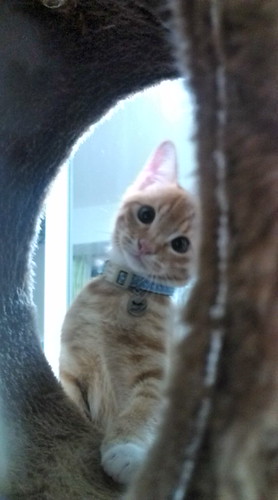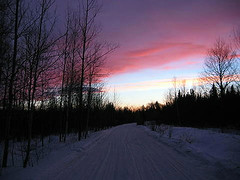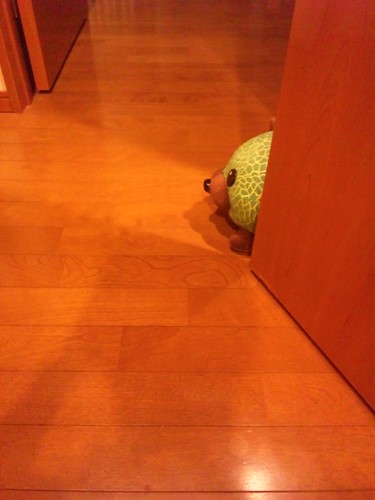ds106 assignment on Haiku. This assignment has been getting considerable traction as of late, so although I initially resolved to stay away from it for perceived lack of understanding of what actually makes a haiku tick..
“Here in US schools, we are taught the haiku merely as the formula of syllables…”?-CogDog.
I re-thought my stand and am currently in an, “Eh, why not? You guys can bash me in the comments later,” kind of mood. Still, I think it’s kind of weird how a form of poetry is so intrinsically connected to a particular language and culture (Japanese) that comments such as these can be made, and quite legitimately argued:
“Haiku have very deep system, but it can work for only Japanese language, so this Haiku will be litbit different style from Japanese language Haiku.“ -Komiyama.
As for me I definitely feel that there is a kind of wall between haiku and any unfortunate non-Japanese (or non-Japanese speaker) who decides to take on the task of making a haiku of his/her own. This wall can of course be true, or only perceived but I’d like to get peoples’ opinions on the matter because I’m not entirely sure which it is. Similarly would anyone know of any other form of poetry (or literary form etc.) that might be specific to a certain language or culture? I can’t think of any at the moment but I would be surprised if haiku were to be the only case.
So anyway enough stalling. I said I’d present my own haiku and present it I will so here you go:
Comes early in the morning
Not now, Pikachu”
Sunshine by yeow_tuj via Share-Alike, Attribution CC Licensing. It’s my photo and I’ll do whatever I please with it!
Sunshine by yeow_tuj via Share-Alike, Attribution CC Licensing. It’s my photo and I’ll do whatever I please with it!
I moved into my new apartment about 4 months ago, and while it’s awesome there is the slight issue of my sleeping area being right in front of a ginormous (omg this is actually a word?) window. The window’s frosted, but that doesn’t stop copious amounts of sunlight pouring into the room on sunny mornings and that’s what my haiku was trying to convey I guess. Everyone knows the feeling of not wanting to get up yet, but in addition to alarm clocks and lack of coffee I always feel that the sun itself is trying to slap me awake in the morning…and then when I’m actually up and conscious I look at my watch and I actually still had time to spare. And then there’s a huge Pikachu head behind me. I need my coffee.
As for the considerations I tried to follow the “rules” that I got from some related blogs (CogDog, Hamazaki, Komiyama, Lockman). Each of them brought something different to the table, which was nice when trying to compare and contrast and see what has to be done and what can be left open to interpretation…but at the same time it became a little confusing? CogDog and Lockman’s takes were quite thoughtful, with the former taking on an almost philosophical air and the latter being quite emotional/personal. Contrast this to the wildly differing styles of Hamazaki and Komiyama, wherein I found the former’s to be very instructional and insightful, almost rigid in its “professional” take (I wonder how long the post took..), while conversely when reading Komiyama’s haiku I get a very light-hearted, sentimental and playful feeling coming across that might or might not adhere as soundly to the principles of haiku, but definitely comes across to this uninformed non-Japanese as so much more engaging…on a fuzzy feline kind of level. I like cats, call me biased. 
Going back to Hamazaki’s post however, I definitely found the write-up to be the most informative, with the general guidelines of:
- Use three lines of up to 17syllables. (I split mine into 5/7/5)
- Use a season word (kigo). (Sunshine in the morning? Maybe Summer-ish. As CogDog says, “…no idea where they fit in the Japanese seasons.” But then again as Hamazaki says, “almost all the nouns were categorized into one of the four seasons a hundred years ago, but we cannot do that any more in these days,” so maybe I’ll be let off the hook this time..)
- Use a cut or kire (sometimes indicated by a punctuation mark) to compare two images implicitly. (The last line)
So in conclusion there you have my haiku. Maybe it’s off, maybe it’s not. Maybe Ben’s comment is right? What do you guys think?
“I’m not sure it’s the translation into English that a Haiku potentially loses its authenticity, but rather then different pace and tone that many westerners, particularly Americans, bring to the form.” -Ben.













